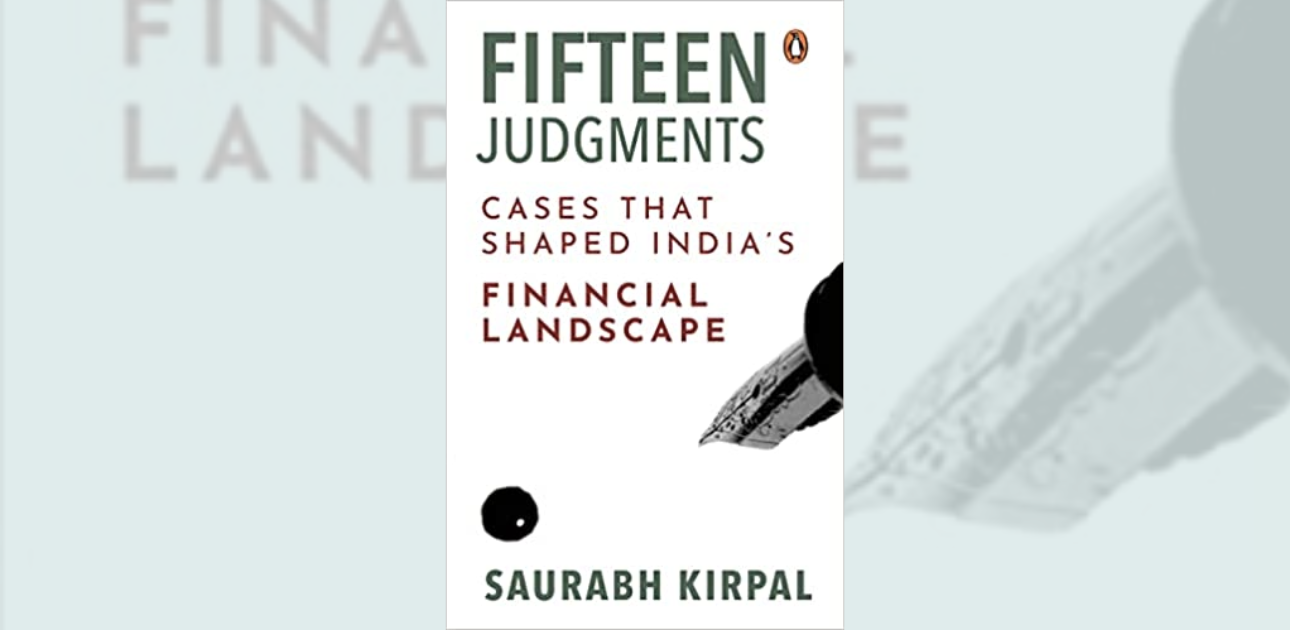Senior advocate of the Delhi High Court, Saurabh Kirpal, has in this lucidly-written book, dealt with the interface between the law and the economy, to enhance the legal literacy of the average reader. With the mainstream media displaying a tendency to ignore judgments impinging on financial matters, there is a distinct void to be filled in the world of legal journalism.
Why and how did Kirpal choose 15 judgments especially when there are many that can make a claim to influencing the financial destiny of the country as well as that of the common man? Kirpal answers that he was keen to choose those that lie on the cusp of law and economic policy.
Many judgments of the Courts, he says, can affect the financial health of an individual or a family. For instance, cases relating to succession and matters of inheritance will have a greater impact on the affected individuals than a case about telecom licenses. In the larger scheme of things, however, it is judgments that have a macroeconomic dimension which have a long-term impact on the economy of the country, he suggests.

Kirpal is of the view that it is not possible to fully understand the economic jurisprudence of today without examining the past, that is, past precedent. Besides, he reasons that the judgments, and the often knee-jerk reactions opposing them, lay a path for a particular form of economic development. Examining the judgments, as well as the amendments that sought to undo their effect, has a practical impact on determining a future course of action, he says.
The 15 judgments, as Kirpal rightly articulates, also trace the long path of economic history of the country. From the almost laissez-faire conception of the economy in the fifties to the socialism of the seventies and eighties; from the recognition of the effects of liberalization in the nineties to the attempt to rein in the perceived excesses of liberalization, the judgments reflect the sentiment of the era that they were delivered in.
In the early years of the republic, the judicial overreach in favour of the right to property of the zamindars forced Parliament to insert the Ninth Schedule into the Constitution. Over the years, as Kirpal points out, this schedule has been amended and a host of economic and financial laws have been added to it, leaving the citizen with no legal recourse against unjust laws. The Foreign Exchange Regulation Act, 1973 and the Industries (Development and Regulation Act), 1951 are among some of the pieces of legislation that shackled the Indian economy but were immune from judicial oversight because of the insertion into the Ninth Schedule to the Constitution.
How the courts shifted their jurisprudence in the intervening years in favour of socialism is illustrated by Kirpal through his selection of Supreme Court’s judgment in Bangalore Water Supply case for an intense scrutiny. In this case, Kirpal says, the court gave an almost impossibly large definition of the term ‘industry’, in its zeal to cover as many workers as possible. Thus, charitable organisations, professional services like doctors and lawyers, as well as municipal agencies were included under the term ‘industry’.
The book’s study of the pendulum and how it swung left and right in terms of judicial philosophies, shows where Kirpal’s sympathies lie. The hallmark of the 1990s was liberalisation, and its emphasis on disinvestment. The large public sector in the country was bloated and often loss-making: Kirpal has no doubt that it was caused in part due to judgments like the Bangalore Water Supply case, which made it impossible to restructure loss-making businesses.
Kirpal notes that the disinvestment in Bharat Aluminium Company Ltd (BALCO) was challenged before the Supreme Court and the challenge was rejected in an apparent move away from the socialist ideologies of the seventies and eighties. This judgment, as Kirpal rightly observes, led to more privatizations and was part of the opening of the Indian economy.
Kirpal defends the judicial hands-off approach, as reflected in the court’s reluctance to enter into matters of economic policy. “This is a salutary principle given the lack of democratic participation as well as the competence of the Court in matters of economic policy”, he says.
Kirpal’s views on the Court’s reluctance to enter the policy minefield in at least two fields, namely, corruption and the environment, are not as clear-cut as one wishes. He says that the Court went a step beyond and proceeded to cancel all the licences of the telecom companies, including those that had bought the spectrum in good faith, on the ground that the government did not have the liberty to allocate spectrum, and that it was mandatory to auction it. Kirpal is of the view that the judgment had a devastating impact on the companies and the telecom sector as a whole, “one that we are still dealing with”.
Kirpal is of the firm view that economic growth is strongly tied to, and indeed requires, a robust rule of law. Businesses need to have faith in the predictability of the regulatory regimes governing them before making investments, he says. It is in this context, he is critical of the uncertainty following repeated amendments to the Insolvency and Bankruptcy Code since 2016. According to him, the repeated amendments show that either the original law was not drafted properly or that the government is too trigger-happy with amendments.
The RBI’s regulations making it impossible to deal in bitcoins and other cryptocurrencies and the lack of comprehensive policy surrounding their use after the Supreme Court struck down the ban on them in 2019, also come in for critical review for the same reason.
Kirpal is also critical of the implementation of the POSH (Prevention of Sexual Harassment at Workplace) Act, 2013, for what he calls as “further evidence of the falling standards of legislative draftsmanship and parliamentary debates”. Substantial time had passed since the Visakha judgment, but the hope to improve upon the guidelines suggested by the Court had been dashed, he laments. Kirpal recommends imposition of deterrent penalties not only on the person committing the harassment, but also vicariously on the organisation. According to him, it is time for the Supreme Court to step in again, to ensure a comprehensive absence of harassment, both in the formal as well as informal sector.
In cases concerning environment versus development, Kirpal is in favour of a more holistic and nuanced approach, rather than leaving the ultimate control to the courts. One possible solution, he says, is to set up a truly independent environmental regulator, which would be free of the pulls and pushes of any particular lobby. Judgments of the courts are a wake-up call for the government to do justice to both equally, he suggests.
A must-read for those yearning for a balanced view on some of the contemporary debates concerning the role of India’s judiciary in sustainable development.


